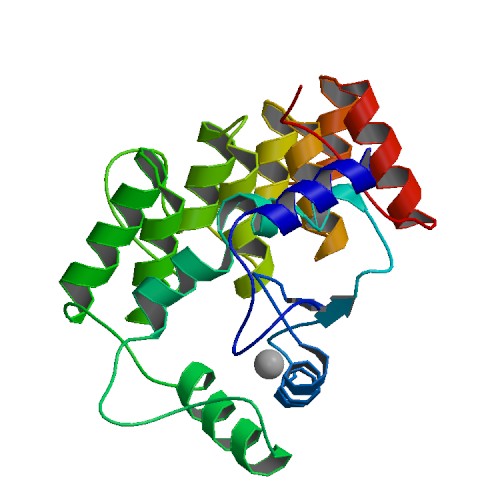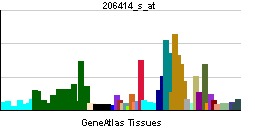DDEF2
| Development and differentiation enhancing factor 2 | |||||||||||||
|---|---|---|---|---|---|---|---|---|---|---|---|---|---|
 PDB rendering based on 1dcq. | |||||||||||||
| |||||||||||||
| Identifiers | |||||||||||||
| Symbols | DDEF2 ; PAP; AMAP2; FLJ42910; KIAA0400; PAG3; Pap-alpha; SHAG1 | ||||||||||||
| External IDs | Template:OMIM5 Template:MGI HomoloGene: 2888 | ||||||||||||
| |||||||||||||
| RNA expression pattern | |||||||||||||
 | |||||||||||||
| More reference expression data | |||||||||||||
| Orthologs | |||||||||||||
| Template:GNF Ortholog box | |||||||||||||
| Species | Human | Mouse | |||||||||||
| Entrez | n/a | n/a | |||||||||||
| Ensembl | n/a | n/a | |||||||||||
| UniProt | n/a | n/a | |||||||||||
| RefSeq (mRNA) | n/a | n/a | |||||||||||
| RefSeq (protein) | n/a | n/a | |||||||||||
| Location (UCSC) | n/a | n/a | |||||||||||
| PubMed search | n/a | n/a | |||||||||||
Development and differentiation enhancing factor 2, also known as DDEF2, is a human gene.[1]
This gene encodes a multidomain protein containing an N-terminal alpha-helical region with a coiled-coil motif, followed by a pleckstrin homology (PH) domain, an Arf-GAP domain, an ankyrin homology region, a proline-rich region, and a C-terminal Src homology 3 (SH3) domain. The protein localizes in the Golgi apparatus and at the plasma membrane, where it colocalizes with protein tyrosine kinase 2-beta (PYK2). The encoded protein forms a stable complex with PYK2 in vivo. This interaction appears to be mediated by binding of its SH3 domain to the C-terminal proline-rich domain of PYK2. The encoded protein is tyrosine phosphorylated by activated PYK2. In vitro it shows strong GTPase-activating protein (GAP) activity towards the small GTPases ADP-ribosylation factor (ARF) 1 and ARF5 and weak activity towards ARF6. The encoded protein is believed to function as an ARF GAP that controls ARF-mediated vesicle budding when recruited to Golgi membranes. In addition, it functions as a substrate and downstream target for PYK2 and SRC, a pathway that may be involved in the regulation of vesicular transport.[1]
References
Further reading
- Ishikawa K, Nagase T, Nakajima D; et al. (1998). "Prediction of the coding sequences of unidentified human genes. VIII. 78 new cDNA clones from brain which code for large proteins in vitro". DNA Res. 4 (5): 307–13. PMID 9455477.
- Brown MT, Andrade J, Radhakrishna H; et al. (1998). "ASAP1, a phospholipid-dependent arf GTPase-activating protein that associates with and is phosphorylated by Src". Mol. Cell. Biol. 18 (12): 7038–51. PMID 9819391.
- Andreev J, Simon JP, Sabatini DD; et al. (1999). "Identification of a new Pyk2 target protein with Arf-GAP activity". Mol. Cell. Biol. 19 (3): 2338–50. PMID 10022920.
- Kondo A, Hashimoto S, Yano H; et al. (2000). "A new paxillin-binding protein, PAG3/Papalpha/KIAA0400, bearing an ADP-ribosylation factor GTPase-activating protein activity, is involved in paxillin recruitment to focal adhesions and cell migration". Mol. Biol. Cell. 11 (4): 1315–27. PMID 10749932.
- Uchida H, Kondo A, Yoshimura Y; et al. (2001). "PAG3/Papalpha/KIAA0400, a GTPase-activating protein for ADP-ribosylation factor (ARF), regulates ARF6 in Fcgamma receptor-mediated phagocytosis of macrophages". J. Exp. Med. 193 (8): 955–66. PMID 11304556.
- Kim H, Lee Y (2002). "Interaction of poly(A) polymerase with the 25-kDa subunit of cleavage factor I.". Biochem. Biophys. Res. Commun. 289 (2): 513–8. doi:10.1006/bbrc.2001.5992. PMID 11716503.
- Oshiro T, Koyama S, Sugiyama S; et al. (2002). "Interaction of POB1, a downstream molecule of small G protein Ral, with PAG2, a paxillin-binding protein, is involved in cell migration". J. Biol. Chem. 277 (41): 38618–26. doi:10.1074/jbc.M203453200. PMID 12149250.
- Strausberg RL, Feingold EA, Grouse LH; et al. (2003). "Generation and initial analysis of more than 15,000 full-length human and mouse cDNA sequences". Proc. Natl. Acad. Sci. U.S.A. 99 (26): 16899–903. doi:10.1073/pnas.242603899. PMID 12477932.
- Ota T, Suzuki Y, Nishikawa T; et al. (2004). "Complete sequencing and characterization of 21,243 full-length human cDNAs". Nat. Genet. 36 (1): 40–5. doi:10.1038/ng1285. PMID 14702039.
- Hashimoto S, Hashimoto A, Yamada A; et al. (2004). "A novel mode of action of an ArfGAP, AMAP2/PAG3/Papa lpha, in Arf6 function". J. Biol. Chem. 279 (36): 37677–84. doi:10.1074/jbc.M404196200. PMID 15231847.
- Kojima C, Hashimoto A, Yabuta I; et al. (2005). "Regulation of Bin1 SH3 domain binding by phosphoinositides". EMBO J. 23 (22): 4413–22. doi:10.1038/sj.emboj.7600442. PMID 15483625.
- Gerhard DS, Wagner L, Feingold EA; et al. (2004). "The status, quality, and expansion of the NIH full-length cDNA project: the Mammalian Gene Collection (MGC)". Genome Res. 14 (10B): 2121–7. doi:10.1101/gr.2596504. PMID 15489334.
- Onodera Y, Hashimoto S, Hashimoto A; et al. (2005). "Expression of AMAP1, an ArfGAP, provides novel targets to inhibit breast cancer invasive activities". EMBO J. 24 (5): 963–73. doi:10.1038/sj.emboj.7600588. PMID 15719014.
- Olsen JV, Blagoev B, Gnad F; et al. (2006). "Global, in vivo, and site-specific phosphorylation dynamics in signaling networks". Cell. 127 (3): 635–48. doi:10.1016/j.cell.2006.09.026. PMID 17081983.
- Ewing RM, Chu P, Elisma F; et al. (2007). "Large-scale mapping of human protein-protein interactions by mass spectrometry". Mol. Syst. Biol. 3: 89. doi:10.1038/msb4100134. PMID 17353931.
| This protein-related article is a stub. You can help Wikipedia by expanding it. |